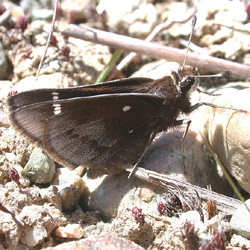Find a Butterfly
Dusted Skipper
Atrytonopsis hianna
Named
Scudder, 1868

Identification
A medium sized, blackish-brown species readily distinguished from other dark skippers by the combination of the pattern of small white spots on the forewings above and the distinctive whitish "dusting" on the underside. Also note a conspicuous white line over the eye and the white dot (usually present) near the base of the hindwing below. Few other dark skippers are likely to be found in old fields in May; however, compare the duskywings.
Distribution
East of the Rockies from southeastern Saskatchewan and northern New Mexico east to central New England and Florida. Absent from large areas of this range, e.g. from the southeastern coastal plain, and much of New York, Pennsylvania and the north central states Northern-most New England record appears to be from Durham, New Hampshire, and "should be found" from nearby southernmost Maine where appropriate habitat exists (Brower, 1974).
Status in Massachusetts
Locally fairly common in its season, though seldom seen in numbers. Widespread except for Berkshire County where atlas workers could not find it. Scudder knew it from only a few localities in Massachusetts, Springfield being the farthest west. Maximum: 57, 31 May 1993, Foxboro (Norfolk Co.).

Flight Period in Massachusetts
Late May to mid-July; commonest in early to mid-June. Extreme Dates: 20 May 1991 at W. Boylston (Worcester Co.), T. Dodd.
Larval Food Plants
In Massachusetts mainly Little Bluestem grass (Schizachyrium [Andropogon] scoparium), but also recorded here from Big Bluestem (Andropogon gerardi).
Adult Food sources
Visits a wide variety of herbs and shrubs that flower during its flight period. During the Atlas it was recorded on Larger Blue Flag, Dewberry, Wild Geranium, and Common Hawkweed*

Habitat
Old fields, sandy barrens, rocky outcrops and other areas of poor soils or where fire maintains vegetation in an early successional stage. These are the conditions that favor the Dusted Skipper’s food plant, Little Bluestem grass.
Life Cycle
EGGS: Dome-shaped, bright yellow, turning tan at the top; smooth (minute punctures). LARVA: Pink-lavender above with grayish sides; covered with long yellowish hairs; green and brown larvae also reported; neck gray with blackish collar; head dark brown to purple; thoracic spiracles red; makes a tent-like structure by fixing several leaves together with its silk. CHRYSALIS: Pale brown with pink and orange tones on the abdomen; smooth and cylindrical; OVERWINTERING STAGE: Mature caterpillar winters in a sealed hibernaculum of leaves near the base of the food plant.
Like the Cobweb Skipper with which it shares its habitat, food preferences and early flight period, the Dusted Skipper is often seen sunning and awaiting passing females on low vegetation or stones amid the dead stems of the previous year‘s grasses.
Account Author
Chris Leahy



